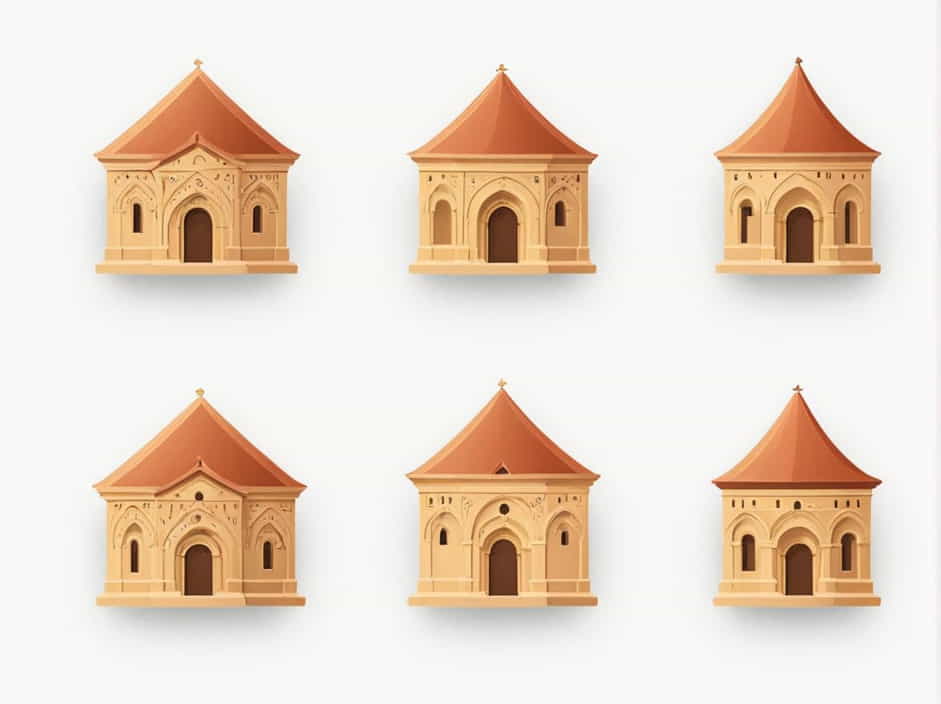Romanesque architecture is a distinctive architectural style that flourished in Europe from the 10th to the 12th century. It is known for its massive walls, rounded arches, and fortress-like appearance. Recognizing Romanesque architecture is relatively easy if you know what to look for. This topic explores the defining characteristics of this medieval architectural style and how to identify it.
What Is Romanesque Architecture?
Romanesque architecture is an architectural style inspired by ancient Roman design, particularly in its use of round arches and thick stone walls. It emerged around the 10th century and dominated European church and monastery construction until it evolved into the Gothic style in the 12th century.
This architectural style is most commonly found in cathedrals, churches, abbeys, and castles, many of which still stand today.
Key Features of Romanesque Architecture
Romanesque buildings have distinctive characteristics that make them easy to recognize. Below are some of the most notable features.
1. Rounded Arches
One of the most defining elements of Romanesque architecture is the use of rounded arches. These arches are found in doorways, windows, and arcades, giving the buildings a sturdy and symmetrical appearance.
- Unlike Gothic architecture, which features pointed arches, Romanesque buildings always have semi-circular arches.
- The use of round arches comes from ancient Roman architecture, which heavily influenced the Romanesque style.
2. Thick Stone Walls
Romanesque buildings are known for their thick and heavy stone walls. These walls were designed to:
- Provide structural support for large stone roofs.
- Offer protection in an era where security was a concern.
- Keep the interior cool in warm climates.
The massive walls give Romanesque buildings a fortress-like appearance, making them look strong and imposing.
3. Small, Narrow Windows
Since Romanesque buildings have thick walls, they cannot support large windows. As a result:
- Windows are small and narrow, often appearing like arrow slits.
- Stained glass is rare in early Romanesque churches because the windows are too small.
- Interiors tend to be dark and dimly lit, creating a mystical atmosphere.
4. Barrel and Groin Vaults
To support their heavy roofs, Romanesque architects used vaulted ceilings instead of wooden beams. The two most common vaulting techniques are:
- Barrel Vaults – A continuous series of rounded arches, forming a tunnel-like ceiling.
- Groin Vaults – Created by the intersection of two barrel vaults, allowing for stronger support.
These vaults helped distribute weight evenly, reducing the pressure on walls and columns.
5. Large Towers
Romanesque buildings often feature tall, square, or cylindrical towers that serve both decorative and functional purposes.
- Towers were used to enhance the height of churches and cathedrals.
- They also acted as watchtowers for protection in medieval times.
Most Romanesque churches have two towers flanking the main entrance, a feature later adopted in Gothic cathedrals.
6. Decorative Arcades and Blind Arches
Although Romanesque architecture is often seen as solid and heavy, it includes decorative elements such as:
- Arcades (series of arches) – Found on facades, cloisters, and interiors, adding rhythm to the design.
- Blind Arches (arched designs without openings) – Used to decorate exterior walls and give a sense of depth.
These decorative elements soften the fortress-like appearance of Romanesque buildings.
7. Sculptural Ornamentation
Romanesque churches feature richly carved decorations, especially around:
- Doorways (portals) – Often adorned with biblical scenes and religious symbols.
- Capitals of columns – Decorated with figures of saints, animals, or mythological creatures.
- Friezes and relief carvings – Depicting scenes from the Bible and medieval life.
The sculptures were used to educate the illiterate population about Christian teachings.
Examples of Romanesque Architecture
Many famous buildings exhibit classic Romanesque architecture. Some of the most well-known examples include:
1. Santiago de Compostela Cathedral (Spain)
This pilgrimage church is one of the most famous Romanesque buildings in Europe. It features rounded arches, thick walls, and impressive towers.
2. Durham Cathedral (England)
Durham Cathedral is an excellent example of the transition from Romanesque to Gothic architecture. It has massive piers, ribbed vaulting, and Norman-style decoration.
3. Speyer Cathedral (Germany)
Built in the 11th century, Speyer Cathedral showcases large towers, thick stone walls, and a barrel-vaulted ceiling, typical of the Romanesque style.
4. Pisa Cathedral (Italy)
Part of the famous Piazza dei Miracoli, this cathedral features rounded arches, blind arcades, and decorative patterns that highlight Romanesque elegance.
5. Cluny Abbey (France)
Once the largest church in Europe, Cluny Abbey was a masterpiece of Romanesque architecture, influencing many later cathedrals.
How to Differentiate Romanesque from Gothic Architecture
Romanesque architecture was eventually replaced by the Gothic style, which introduced new architectural innovations. Here’s how they differ:
| Feature | Romanesque Architecture | Gothic Architecture |
|---|---|---|
| Arches | Rounded arches | Pointed arches |
| Walls | Thick and heavy | Thinner with buttresses |
| Windows | Small, narrow windows | Large stained-glass windows |
| Ceilings | Barrel and groin vaults | Ribbed vaults |
| Decorative Style | Simple and solid | Elaborate and ornate |
Romanesque buildings look strong and fortress-like, while Gothic structures appear tall and delicate due to flying buttresses and large windows.
Recognizing Romanesque architecture is simple once you understand its key features. Look for rounded arches, thick stone walls, small windows, barrel vaults, and decorative arcades. These characteristics define one of the most influential architectural styles of medieval Europe.
Many Romanesque churches and cathedrals still stand today, serving as historical landmarks and testaments to medieval craftsmanship. Whether visiting cathedrals in Spain, England, Germany, Italy, or France, these structures remain awe-inspiring examples of Romanesque artistry and engineering.
